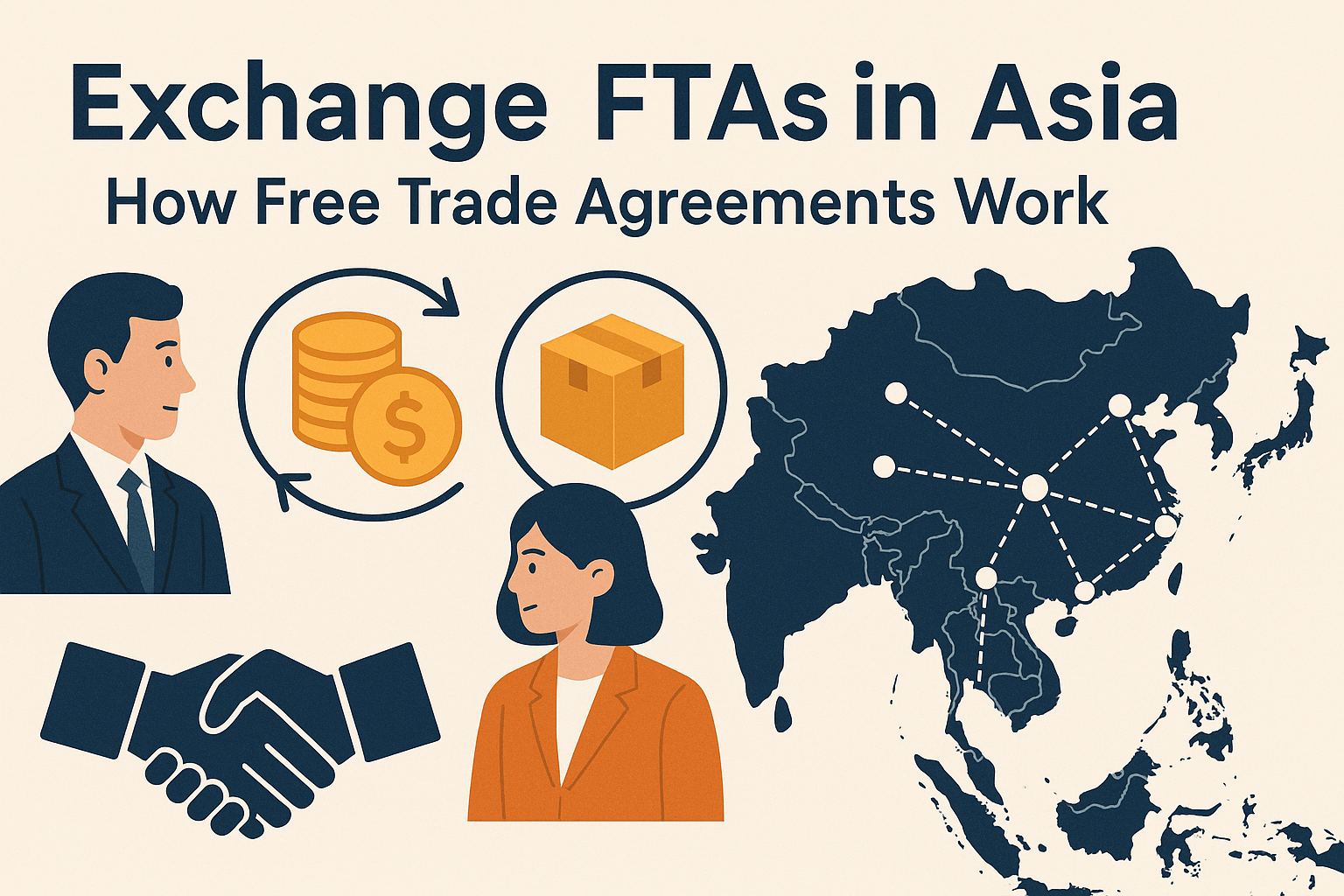If you’ve ever been to a bustling port city in Asia — say, Singapore or Busan — you know there’s something almost poetic about the rhythm of trade. Ships unload crates of electronics from Japan, trucks line up with textiles from Vietnam, and cranes swing steel from China into Thai warehouses. Beneath that dance lies something powerful and mostly invisible: Exchange FTAs in Asia Trading: How Free Trade Agreements Work.
Free Trade Agreements — or FTAs — don’t scream their presence. There are no flashing signs that tell you a product avoided a 15% tariff because of a regional treaty. But make no mistake, these quiet documents shape nearly every transaction that flows across Asian borders. And in many ways, they define how Asia trades with itself and with the rest of the world.
Setting the Stage: What Are FTAs, Really?
Let’s back up a bit. A Free Trade Agreement is essentially a pact between two or more countries that agree to lower or eliminate barriers to trade between them — think tariffs, quotas, import bans, even regulatory restrictions. When done right, FTAs create smoother, faster, and cheaper trade channels.
But FTAs in Asia are not your textbook examples. They’re layered, dynamic, and often political. Each one comes with its own flavor — some are deep and comprehensive, covering everything from digital services to labor rights. Others are narrowly focused on reducing tariffs on agricultural goods or car parts.
When we talk about Exchange FTAs in Asia Trading How Free Trade Agreements Work, we’re talking about more than customs duties. We’re talking about geopolitics, supply chain strategies, manufacturing footprints, and even migration patterns.
A Living System: Asia’s Unique Trade Landscape
Asia is a region of contrast — developed powerhouses like Japan and South Korea sit beside emerging markets like Cambodia and Laos. Each economy has different needs, resources, and strategies. That makes FTAs a delicate balancing act.
Take the ASEAN Free Trade Area (AFTA). On paper, it’s one of the most successful multilateral FTAs in the world. Ten Southeast Asian nations agreed to drop tariffs on thousands of goods. But look closer, and the story gets nuanced. Some countries embraced it enthusiastically; others dragged their feet, worried about local industries being undercut by cheaper imports.
Or consider the Regional Comprehensive Economic Partnership (RCEP) — a modern juggernaut of an agreement involving 15 countries, including China, Japan, and Australia. It’s the largest FTA in the world by GDP. But again, implementation varies. RCEP isn’t just about tariff cuts. It sets common rules for e-commerce, intellectual property, and investment protections. It’s a blueprint for how free trade agreements in Asia are evolving — and how complex they’re becoming.
So when we unpack Exchange FTAs in Asia Trading: How Free Trade Agreements Work, we have to keep that context in mind. This isn’t a one-size-fits-all system. It’s a mosaic of overlapping deals, different economic realities, and shifting political winds.
On the Ground: How FTAs Affect Real People and Products
Let’s get a bit more tangible. Say you’re a textile manufacturer in Vietnam. You want to sell your T-shirts to a chain in South Korea. Thanks to the Vietnam–Korea FTA, you don’t have to pay the 10% tariff that would apply to clothing from countries without an agreement. That makes your price point more competitive. You land the contract.
Now, imagine that same manufacturer is trying to scale up. They start importing better sewing machines from Japan — again, under an FTA that waives duties on industrial equipment. Suddenly, they’re producing more efficiently, exporting more, hiring more locals.
This is how Exchange FTAs in Asia Trading: How Free Trade Agreements Work plays out day to day. It’s not just numbers in a report. It’s small factories expanding. It’s farmers accessing new markets. It’s multinational supply chains becoming more agile because customs procedures are simplified and rules of origin are standardized.
But it’s not always rosy. FTAs can also expose weaker players. A local Malaysian rice producer might struggle when cheaper Thai rice floods in under an ASEAN agreement. In countries without robust safety nets or retraining programs, that can cause real hardship.
And that’s the double-edged nature of free trade: it creates winners and losers. The job of governments — and by extension, of the FTAs themselves — is to smooth that transition, to provide support, to anticipate who gets left behind and why.
The Politics Behind the Agreements
Let’s not pretend these agreements are made in a vacuum. Every line of every FTA is a negotiation. Often, the economic logic is just one part of the puzzle. National pride, historical tensions, and global alliances all play a role.
Japan and South Korea, for instance, have deep commercial ties but a historically rocky relationship. That tension has delayed and complicated various trade discussions. Meanwhile, China’s growing dominance has pushed smaller nations to sign FTAs with multiple partners as a kind of insurance policy — a way to stay balanced in a game played by giants.
The Exchange FTAs in Asia Trading How Free Trade Agreements Work often reflects this chessboard dynamic. Countries don’t just sign FTAs to reduce tariffs. They do it to signal alignment, to build leverage, to hedge bets. Trade becomes diplomacy — sometimes overt, sometimes quiet.
This is particularly evident in how India has approached trade deals. While a member of several FTAs, India famously walked away from RCEP, citing concerns over its trade deficit with China. That decision was part economic caution, part political signaling. It showed that even when the numbers line up, national strategy can override.
The Hidden Workings: Certificates, Rules, and Realities
FTAs sound smooth in theory, but the actual paperwork can be brutal. To benefit from an FTA, a business has to prove that its goods qualify under the agreement’s rules of origin. That often involves collecting detailed records, certificates, supplier documents — a mountain of bureaucracy.
One of the most underappreciated aspects of Exchange FTAs in Asia Trading: How Free Trade Agreements Work is this operational layer. Big companies can afford legal teams and consultants. Small exporters in developing nations? Not so much.
That’s why some FTAs go underused. The World Bank has found that “utilization rates” — the percentage of eligible trade that actually claims FTA benefits — can be surprisingly low in Asia. The reasons? Complicated rules, lack of awareness, and administrative burdens.
Some governments are trying to fix this. Singapore has developed digital platforms that automate FTA paperwork. South Korea has created one-stop advisory services for SMEs. These moves are crucial if FTAs are to fulfill their promise — not just on paper, but in ports and factories.
What the Future Holds for Asia’s FTA Web
Asia isn’t standing still. The trade agreements coming out now are more ambitious, more digital, and more integrated. New FTAs are starting to cover things like e-commerce flows, data localization rules, and even environmental standards.
The Exchange FTAs in Asia Trading How Free Trade Agreements Work will continue to evolve as technology and politics shift. Blockchain is being explored for tracking rules of origin. AI is being tested to automate customs decisions. These aren’t just gimmicks. They’re responses to the real-world friction points that still plague cross-border trade.
Geopolitical shifts will also shape the next wave of FTAs. The rise of China, the US–China rivalry, and supply chain diversification strategies post-COVID are all pushing Asia to rethink how it trades — and with whom.
And underneath it all, people will keep adapting. Traders, logistics managers, factory owners, customs brokers — they’ll keep navigating the rules, optimizing the routes, tweaking their strategies to stay competitive in a region that never stops moving.
Final Thoughts: A Quiet Force Reshaping Asia
We often think of international trade as something distant — the domain of diplomats, economists, or corporate lawyers. But when you look at Exchange FTAs in Asia Trading How Free Trade Agreements Work, you realize it’s a human story. A story of entrepreneurs trying to expand. Of workers hoping for better jobs. Of nations trying to find their place in a fast-changing world.
FTAs don’t work magic. They won’t fix everything. But they create opportunity. And in Asia — a region defined by its complexity, its resilience, and its hunger for growth — opportunity means everything.
So the next time you see “Made in Thailand” on a package, or hear about a startup in Jakarta scaling through cross-border deals, remember: behind that moment is likely a quiet piece of paperwork, signed in a boardroom, buried in government archives. A free trade agreement. A handshake across borders. A quiet engine driving the region forward.




